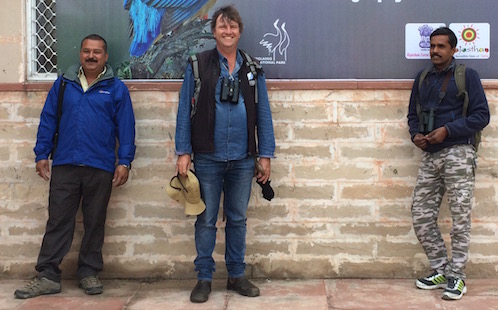
Harish Kumar, Dion Hobcroft, and Gajendra Singh
(Click on images to enlarge)
|
The plan for today was to go birding in the morning and to spend the afternoon
sight-seeing in Delhi. We were up at 6 and down for breakfast by 6:30 to be
ready for the group’s departure by bus to visit
Sultanpur
National Park, about an hour’s drive away. On the trip, we
learned that the bus drivers here have a separate glassed-in compartment at the
head of the bus where they and their driver’s assistant sit. The
assistant has chores like getting out and crossing many lanes of motorway
traffic on foot to pay the necessary taxes when the bus enters a different
state.
Sultanpur is acacia woodland with an extensive wetland area, Sultanpur Jheel, and it was just overflowing with birds. We immediately started seeing Hoopoes and other wonderful birds, as well as the large antelope known as the Nilgai (which strikes me as looking like a sci-fi artist’s concept of a mammal-equivalent on an alien world). |
|
Nilgai |
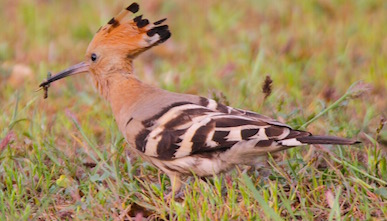 Hoopoe (Image courtesy of Amy Sheldon) |
| We were still near the entrance when we had our first Spotted Owlet looking very sleepy and in the same tree a Brown-headed Barbet: |
|
Spotted Owlet |
 Brown-headed Barbet (Image courtesy of Amy Sheldon) |
| We spent the rest of the morning wandering around the edges of the wetland glorying in the birds. Dion was eager to get the rarities for us all, such as this beautiful White-tailed Lapwing, but for Lee and me the very common Red-wattled Lapwing was also a lifebird: |
|
White-tailed Lapwing |
 Red-wattled Lapwing (Image courtesy of Amy Sheldon) |
| One of the stars of the morning was the Black-rumped Flameback, a large and very colorful woodpecker that we saw repeatedly. And we were delighted to find Indian Spot-billed Ducks, another new bird for us: |
 Black-rumped Flameback (Image courtesy of Amy Sheldon) |
 Indian Spot-billed Ducks (Image courtesy of Amy Sheldon) |
| When we arrived at the national park early in the morning, there were no clouds but the air was grey and not good for photography. Happily, by the end of the morning the air had cleared somewhat and we were getting better photos, such as Amy’s beautiful shots of a Rose-ringed Parakeet and of a now-awake Spotted Owlet: |
 Rose-ringed Parakeet (Image courtesy of Amy Sheldon) |
 Spotted Owlet (Image courtesy of Amy Sheldon) |
|
(It felt right to be seeing Rose-ringed Parakeets in their native land, having
had them squawking above us in London and Brussels and elsewhere around the
world.)
There were many other wonderful birds we didn’t succeed in photographing, especially the Coppersmith Barbet (which has a tinkling call very much like the sound of a coppersmith’s hammering), the Asian Openbill (a nifty stork), the Bar-headed Geese, a pair of Garganey, the perched Shikra (an elegant accipter), the Yellow-footed Green Pigeon, and the male Greater Coucal. Perhaps the loveliest bird of all was a male Black Redstart, its tail like orange fire. |
|
Our main goal for the afternoon was to visit the Qutb Minar and its surrounding
monuments, which are located in a big park that receives even more visitors
annually than the Taj Mahal. It was a wonderful window into ancient India.
The Qutb Minar is the world’s tallest brick minaret, almost 240 feet high. Its exterior is faced with red sandstone and marble carved with beautiful calligraphy. It was built to celebrate the victory of Mohammed Ghori, who came from Afghanistan and defeated the Rajputs in 1192, marking the beginning of Muslim rule in India (long before the Mughals). |
 Qutb Minar |
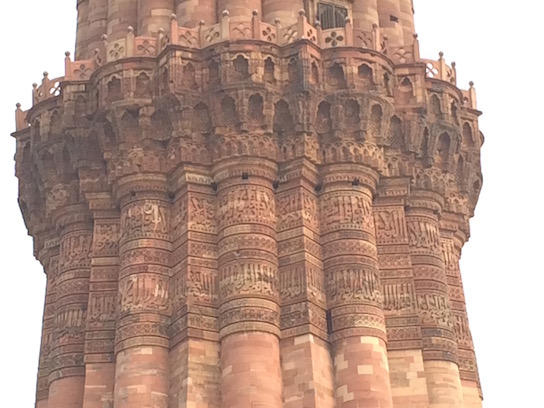 Qutb Minar |
| The most ancient and remarkable artifact in the Qutb complex is one that could easily be overlooked among all the towering masonry, the 7-meter-tall Iron Pillar of Delhi: |
 Iron Pillar of Delhi |
 Detail of Capital |
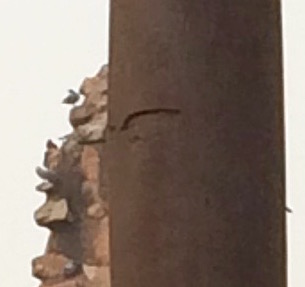 Damage from Cannon Ball |
| Despite the crowds all around us, we found wildlife in the Qutb complex, of course. A Brown Rock-Chat seemed to consider the ruined stone buildings a natural habitat, and the flowerbeds had Jungle Babblers: |
|
Brown Rock-Chat |
 Jungle Babbler (Image courtesy of Amy Sheldon) |
| We found the funniest bird of the day in the gardens below the Qutb Minar, an immature male Purple Sunbird just beginning to get its breeding plumage, its feathers still in their pins—remarkably scruffy looking: |
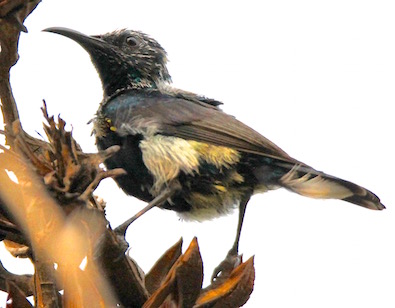 Molting Purple Sunbird (Image courtesy of Amy Sheldon) |
 What It Should Look Like (Image courtesy of Wikimedia Commons) |
|
Upon leaving the Qutb complex, we turned our attention from the Ghurid Empire to
the British Empire, which also built extensively in Delhi, mostly to the designs
of Sir Edwin Lutyens.
Lutyens’ Delhi
reminded me in some ways of other planned capitals, such as Canberra and DC, in
that it made rather profligate use of land and everything seems too far apart,
though one enjoys having so much greenspace. We passed first through the
Lutyens Bungalow
Zone, which contains about a thousand handsome, low, white
houses set in large, lush gardens. One’s impression is of white and dark
green and complete isolation from the realities of Delhi. The ten percent of
these houses that are still in private hands (most belong to the Indian
government) are said to be the most expensive residential real estate in the
world.
We drove on to see the Parliament and other government buildings, most of which were inherited from the Raj. (The Viceroy’s Palace is now the Rashtrapati Bhawan, the President’s House, etc.) Lee managed, from the moving bus, to capture a photo along the Rajpath (“King’s Way”) of the canopy which once held a 50-foot sculpture of King George V in front of the India Gate (the memorial to the soldiers of India who died in vast numbers in World War I) in front of the Rashtrapati Bhawan. As we drove along, we laughed at the sight of two beautiful little Stilts, not ordinarily city birds, cavorting in the Parliamentary fountain. |
|
View Along the Rajpath |
Parliamentary Fountain with Stilts |
| Lee and I had just time enough to upload our photos and start a networked backup going before joining the others for dinner in the hotel. Before beginning to eat, the group went through the evening ritual of checking our checklists for the birds we had seen during the day. I had missed several that the others had seen, but here was my list for the day (lifebirds in bold face): |
| Greylag Goose | Bar-headed Goose | Comb Duck | Gadwall | Eurasian Wigeon |
| Mallard | Indian Spot-billed Duck | Northern Shoveler | Northern Pintail | Garganey |
| Green-winged Teal | Indian Peafowl | Greater Flamingo | Asian Openbill | Indian Cormorant |
| Oriental Darter | Grey Heron | Purple Heron | Eastern Great Egret | Intermediate Egret |
| Eastern Cattle Egret | Indian Pond Heron | Glossy Ibis | Black-headed Ibis | Eurasian Spoonbill |
| Eastern Imperial Eagle | Shikra | Black Kite | Purple Swamphen | Common Moorhen |
| Eurasian Coot | Black-winged Stilt | Red-wattled Lapwing | White-tailed Lapwing | Common Sandpiper |
| Wood Sandpiper | Black-tailed Godwit | Rock Pigeon | Eurasian Collared Dove | Yellow-footed Green Pigeon |
| Greater Coucal | Spotted Owlet | White-throated Kingfisher | Pied Kingfisher | Eurasian Hoopoe |
| Brown-headed Barbet | Coppersmith Barbet | Black-rumped Flameback | Alexandrine Parakeet | Rose-ringed Parakeet |
| Common Woodshrike | Long-tailed Shrike | House Crow | Grey-throated Martin | Red-vented Bulbul |
| Brooks’s Leaf Warbler | Greenish Warbler | Common Tailorbird | Plain Prinia | Lesser Whitethroat |
| Large Grey Babbler | Indian Robin | Oriental Magpie-Robin | Bluethroat | Red-breasted Flycatcher |
| Black Redstart | Indian Chat | Bank Myna | Common Myna | Asian Pied Starling |
| Purple Sunbird | Sind Sparrow |
|
There aren’t many days in my life when I see thirty lifers! The two
barbets are a new family for us, the Asian Barbets. The Common Woodshrike may
be a new family, or it may be just another Vanga. (With all the discoveries
being made as the result of DNA sequencing, the taxonomy of birds is very much
in flux.)
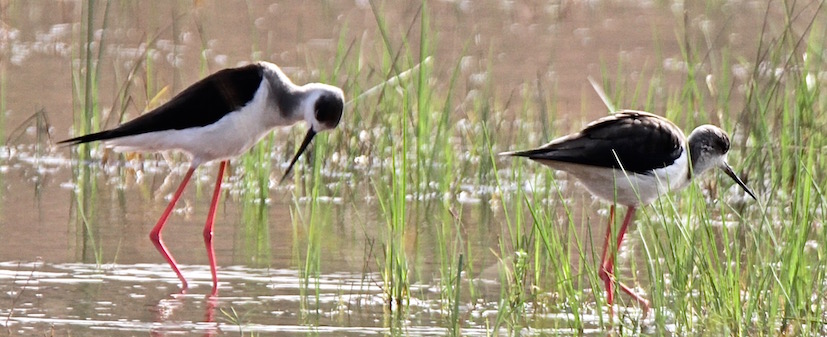 Himantopus himantopus (Image courtesy of Amy Sheldon) While we were doing the checklist, one of our companions pointed out that during the day we’d seen three species whose genus and species names are identical, Anser anser (Greylag Goose), Porphyrio porphyrio (Purple Swamphen), and Himantopus himantopus (Black-winged Stilt). She added that she has a friend who keeps a list of such birds. This became a sort of brain worm for me, and I worked out that while we were in England last week, Lee and I got three others, Buteo buteo (Common Buzzard), Pica pica (Eurasian Magpie), and Vanellus vanellus (Northern Lapwing). Our dear friend Laurie later solved the question for me of what such names are named, which is tautonyms. I am resolved not to let this concept invade my mind.
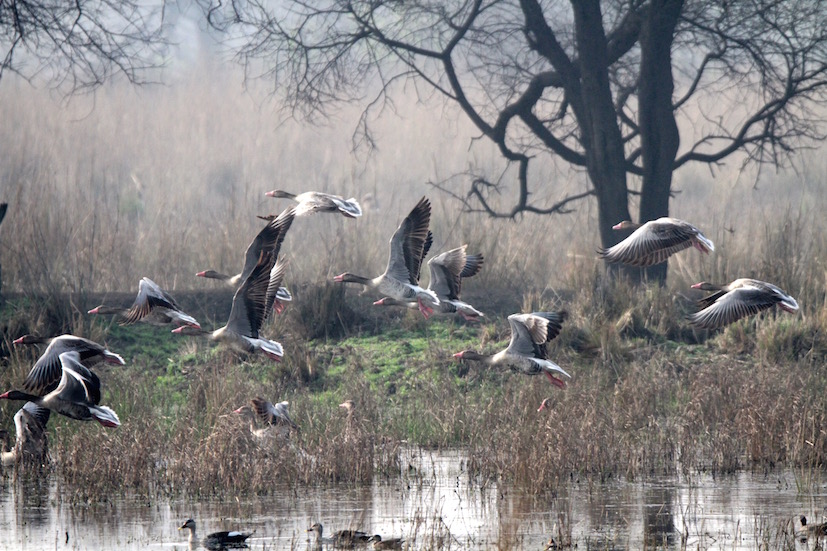 Anser anser (Image courtesy of Amy Sheldon) When we got back to our room, Lee showed me that he had acquired our souvenir rock for the trip, a small piece of the handsome yellow sandstone that is used so widely here. We leave Delhi in the morning to fly to Jodhpur. |

